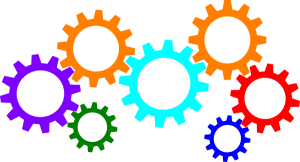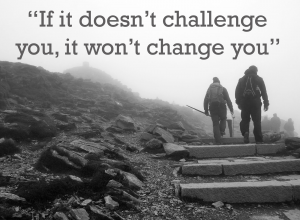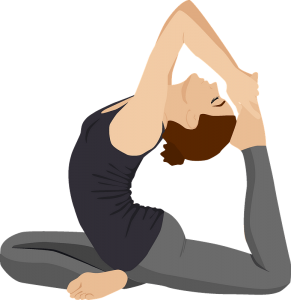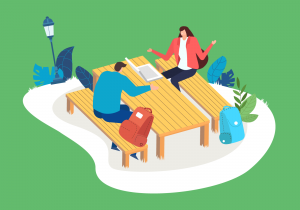Overworked? Burned Out?
 Last month, the website FinanceBuzz released a study of the most overworked cities in the U.S. In the study, researchers looked at metrics such as:
Last month, the website FinanceBuzz released a study of the most overworked cities in the U.S. In the study, researchers looked at metrics such as:
- average number of hours worked per week,
- average commute time and
- percentage of workers who work 50+ weeks per year.
And the winner of the most overworked city is: Washington, D.C. If you’d like to take a closer look at the study and the methodology behind it, here’s a link.
We probably don’t need a study to tell us that the Washington region suffers from a severe case of “overwork.” So many of us feel like we’re doing the work of two or three people and juggling it all can seem like an impossible task. But very few people can keep going at a frantic pace and not experience some symptoms of overwork. A few of the most common symptoms are outlined below:
- Increased stress levels and physical symptoms: People may notice fatigue, headaches or gastrointestinal issues.
- Difficulty sleeping: Sleep behaviors may be disturbed, reduced or increased.
- Decreased productivity: When workloads increase, employees may struggle to keep up, resulting in missed deadlines and making more mistakes.
- Procrastination: Some employees may resort to avoidance and procrastination as a way to deal with overwhelm.
- Increased absenteeism: Increased workloads can cause employees to take more sick leave to deal with stress.
- Decreased job satisfaction: When workers feel overwhelmed and overworked, they may lose motivation and become disillusioned with their jobs. This can often lead to higher rates of turnover, particularly in a competitive job market.
Although they’re similar and often used interchangeably, overwork and burnout are not the same. Overwork refers to the act of working too hard or too much. The term “burnout” was first used in 1974 by German-American psychologist Herbert Freudenberger, who defined it as “the physical or mental collapse caused by overwork or stress.” The key is to identify any symptoms of overwork you may be experiencing (the earlier, the better!), so you can prevent burnout.
Prolonged periods of overwork can begin to take a toll on our mental and physical health, as well as personal relationships. When we overwork and fail to prioritize our own needs and self-care, we don’t give our brain or body what it needs to recuperate. In our next article, we’ll take a look at a few ways to handle increasing workloads. If you notice that your workload is starting to negatively impact your life, working with a coach, like Leah M Joppy and Associates, can be incredibly beneficial. We can help you achieve the balance you’ve been striving for, both professionally and personally, before your day-to-day stressors lead to burnout. Contact us at 301-670-0051 or email us at leah@lmja.com to learn more.
Handling Increasing Workloads
 Steadily increasing workloads may seem like a harsh reality in today’s workplace. Technology ensures that we’re available 24/7. Working from home can make it hard to unplug and create a work/home balance. Falling into the routine of overwork is easy, but getting yourself out of it can feel like an uphill task. However, it’s not impossible and your mental and physical health may depend on it.
Steadily increasing workloads may seem like a harsh reality in today’s workplace. Technology ensures that we’re available 24/7. Working from home can make it hard to unplug and create a work/home balance. Falling into the routine of overwork is easy, but getting yourself out of it can feel like an uphill task. However, it’s not impossible and your mental and physical health may depend on it.
No one is equipped to go at lightning speed without suffering some mental and/or physical repercussions, whether it’s right now or down the road. We outlined a few symptoms of overwork in our last article. Perhaps you’re dealing with one or more, but feel helpless and wonder if there’s anything you can do about it. Here are 6 suggestions to keep in mind:
- Minimize distractions and identify time-wasters: Suggestions include checking e-mail only a few times a day, staying off social media, using earphones if you work in a loud environment and setting clear boundaries if you work from home with family members in the house.
- Make lists and establish priorities: Write down everything you need to accomplish in a given day and then assign each task a priority. Project managers often use the 4Ds of time management: Do, Delegate, Delay and Drop. Checking off tasks as you complete them can also give a sense of accomplishment. It’s a small, but powerful step!
- Delegate where you can: So many us get in the mindset of, “Oh, it’ll be quicker and easier if I just do it myself.” This is particularly true of new managers. However, if you’re in a position to delegate tasks, do it! There is a limit to what one person can do.
- Sit down and talk with your manager: If you feel comfortable, enlightening your manager about your situation can help you both come up with strategies. But don’t just walk into their office without a plan. Ask yourself if your current workload is acceptable for your role and job description. Come in with your list of priorities to share. And propose a solution you can both discuss.
- Pursue hobbies outside of work: A hobby not only brings fulfillment, but also makes your brain think in different way and takes your mind off your job. If you work remotely, try to pursue a hobby that gets you out of the house.
- Prioritize wellness into your routine: We’re talking exercise, breathing techniques, meditation, anything that helps calm and recharge you.
And remember, you don’t have to go through this alone. Working with a coach, like Leah M Joppy and Associates, can help you chart a clearer path forward. We’ll discuss your unique situation, strategies for dealing with your increasing workload and help you establish possible solutions and clear boundaries. The key is to get ahead of your workload situation before it leads to burnout.
Ready to learn more? Call us at 301-670-0051 or email us at leah@lmja.com.
How Your Organization Can Attract Millennial and Gen Z Employees
 Finding the right employees can be tough, but keeping them can be even tougher. In 2022, 46.2 million workers voluntarily quit their jobs, becoming what’s now known as The Great Resignation. And it’s estimated that 46% of the American workforce wants to switch jobs in 2023, making employee retention a key concern. Now more than ever, organizations need to come up with fresh approaches to retain their current workers. This is especially true of Millennial and Gen Z employees.
Finding the right employees can be tough, but keeping them can be even tougher. In 2022, 46.2 million workers voluntarily quit their jobs, becoming what’s now known as The Great Resignation. And it’s estimated that 46% of the American workforce wants to switch jobs in 2023, making employee retention a key concern. Now more than ever, organizations need to come up with fresh approaches to retain their current workers. This is especially true of Millennial and Gen Z employees.
Let’s take a look at these two groups. Millennials were born between 1981 and 1996 while Gen Z refers to those born between 1997 and 2012. Between the two of them, they make up almost 50% of the workforce today. Gen-Z alone is expected to form 27% of the workforce in the next two years. Both Millennials and Gen Z have a reputation for job hopping and lacking “company loyalty”. However, if organizations make an effort to understand the needs and wants of these two groups and grant them the opportunities to grow and thrive, this reputation isn’t always true.
Your recruitment strategies may have helped you acquire a new crop of employees, but if they are not rewarded appropriately with career opportunities, development and other incentives, there is a larger risk of them leaving. What are some of the top things that Millennials and Gen Z look for in an employer? Here’s a glimpse at 5 of them:
- Offer them flexibility and work-life balance: Some may bristle at the work-from-home or hybrid model, but it’s here to stay. Gen Z and millennial employees value flexible work places and working practices and are interested in jobs that will be adaptable to their lifestyle.
- Place an emphasis on their well-being: Millennials and Gen Z want to work for organizations who take care of them and their health as individuals. And it’s not just about physical well-being, but mental health as well.
- Provide them with strong, transparent managers: Management really matters! Grant these two groups more autonomy and less micromanagement, communicate openly and seek their input and ideas.
- Invest in their growth: Gallup found that 87% of millennials rate development opportunities as important to them in a job and LinkedIn found that 76% of Gen Z say learning is key to their success.
- Provide them with mentors: A study by CNBC found that 90% of employees who have assigned mentors say they are happy in their jobs. And greater employee satisfaction leads to better retention!
In today’s multigenerational workforce, organizations can no longer rely on a one-size-fits-all approach to retaining and motivating employees. The most successful organizations truly understand employees’ expectations in the workplace. Leah M Joppy and Associates can work with your organization to build an effective employee retention strategy and help you create programs, systems and communication styles that they meet different employee needs, whatever generation they are from.
Ready to learn more? Call us at 301-670-0051 or email us at leah@lmja.com.
The Composition Of An Effective Team
 Have you ever been a member of (or led) an exceptional workplace team? What are some of the positives that come to mind? Was it engaging and collaborative? Did you meet and exceed your goals? Did everyone feel valued and appreciated? It’s a great feeling, isn’t it? Yet all too often, teams fall short of being as effective as they can be and reaching their potential. The impacts are felt by employees, leaders and organizations as a whole.
Have you ever been a member of (or led) an exceptional workplace team? What are some of the positives that come to mind? Was it engaging and collaborative? Did you meet and exceed your goals? Did everyone feel valued and appreciated? It’s a great feeling, isn’t it? Yet all too often, teams fall short of being as effective as they can be and reaching their potential. The impacts are felt by employees, leaders and organizations as a whole.
So, what exactly do we mean by an “effective team”? It’s the capacity of a group of people, usually with complementary skills, to work together to achieve its goals and objectives. And it’s one of the biggest indicators of an organization’s success. According to Gallup, teams that rank in the top 20% for connectedness see 41% less absenteeism, 59% less employee turnover and a 66% increase in employee wellness. With numbers like that, it’s hard to argue that high performing teams are an integral part of your organization and worth the investment to develop and nurture.
Teams are as varied and unique as the people within them, but when it comes to effective, high performing teams, there are some common characteristics:
- Clear, achievable goals
- A shared commitment
- Clarity of roles and responsibilities
- A sense of purpose
- Clear processes and procedures
- Joint accountability
- A result-oriented approach
Effective teams also tend to show greater resilience by working through challenges and bouncing back from adversity. They also tend to maintain vitality and the energy needed for future success.
It’s no surprise that an effective team is only as strong as the person leading it. In our next article, we’ll get into more about what it takes to lead a high-performance team. The right leadership enhances a team’s success, but far too often, people are placed in leadership roles without any proper leadership development training. It’s vital for leaders to take advantage of every opportunity to enhance their leadership skills. However, it’s also vital for organizations to provide these opportunities in the first place. Working with a coach like Leah M Joppy and Associates can help your leaders identify their strengths and weaknesses and develop the skills needed to build effective teams (strong communication, building trust and resiliency, defining roles and responsibilities and so much more).
Do you want to lead a high performing team, but don’t know where to start? Contact Leah M Joppy and Associates at 301-670-0051 or email us at leah@lmja.com to learn more and get started.
Top Five Suggestions For Leading An Effective Team
 Today’s leaders often feel like they’re in a never-ending game of tug-of-war. Between dealing with day-to-day obstacles, managing projects and team members, it can be overwhelming. The “people” component is certainly the most integral to an organization and can prove to be the most challenging. Building a high-performing team is more than just putting together a group of talented people with the right skills. It requires careful development of each member’s unique talents and characteristics.
Today’s leaders often feel like they’re in a never-ending game of tug-of-war. Between dealing with day-to-day obstacles, managing projects and team members, it can be overwhelming. The “people” component is certainly the most integral to an organization and can prove to be the most challenging. Building a high-performing team is more than just putting together a group of talented people with the right skills. It requires careful development of each member’s unique talents and characteristics.
There is so much strong leaders can do to build effective, high-performing teams. Here’s a look at the top five suggestions. But remember, it’s a marathon and not a sprint. It’s a continuous process and not a “one and done” task:
- Establish meaning and purpose: It’s a leader’s job to help employees and teams find meaning in their work. To increase productivity and motivation, have discussions about the “why” of your team’s tasks. Team members who are passionate and motivated help drive team effectiveness because they understand how their work contributes to the organization’s overall objectives.
- Define roles and responsibilities: Leaders must ensure that everyone on the team knows exactly what is expected of them. It reduces confusion and conflict and allows teams to work more efficiently. Role clarity also enables leaders to hold team members accountable for their performance and identify areas where someone may struggle.
- Communicate effectively: Effective communication and effective leadership are definitely intertwined and it can make, or break, a team. As a leader, it’s vital to: practice active listening and allow people to give constructive feedback without fear of repercussions; ask questions and don’t be defensive; have an open-door policy; follow through with actions.
- Focus on building relationships: Building relationships helps to create (or reinforce) an organization’s values and culture. Once leaders and team members genuinely trust and respect each other, regular, open dialogue about individual and team performance increases team effectiveness.
- Provide productive, specific and timely feedback: Feedback is critical to improving performance, but how you deliver it can make a big difference. Productive feedback enables team members to see their successes and missteps and grow from the experience.
To build high-performing teams, organizations must cultivate high-performing leaders. People skills typically account for 80 percent of success in a leadership role. Yet many people are promoted into leadership because of their technical capabilities, without mastering the skills of managing and motivating others. Without these basic skills, leaders at every level can struggle with building high-performing teams. Leah M Joppy and Associates understands the challenges that accompany leadership roles and knows the proven techniques for building strong leaders who can build motivated, productive teams.
Ready to learn more? Call us at 301-670-0051 or email us at leah@lmja.com.
The Power of Mental Strength
 Have you ever thought about what makes people excel in a particular area, whether it’s a successful career, playing a musical instrument or running a marathon with an amazing time? Most of us would say it’s a person’s intelligence or natural talent that enables them to achieve such incredible results. However, there may be one important factor that you’re not taking into consideration: mental strength. Mental strength is the capacity of a person to deal effectively with stressors, pressures and challenges and perform to the best of their ability, regardless of their circumstances. Call it grit, resiliency or toughness, it’s the key reason why some people are able to overcome obstacles, while others crumble more easily with the daily challenges and frustrations of life.
Have you ever thought about what makes people excel in a particular area, whether it’s a successful career, playing a musical instrument or running a marathon with an amazing time? Most of us would say it’s a person’s intelligence or natural talent that enables them to achieve such incredible results. However, there may be one important factor that you’re not taking into consideration: mental strength. Mental strength is the capacity of a person to deal effectively with stressors, pressures and challenges and perform to the best of their ability, regardless of their circumstances. Call it grit, resiliency or toughness, it’s the key reason why some people are able to overcome obstacles, while others crumble more easily with the daily challenges and frustrations of life.
You’ve probably seen evidence of this in your own life. Do you remember someone who was an incredible musician, but squandered their talent? How about your high school teammate who consistently worked the hardest and squeezed the most out of their potential? Maybe you were set on accomplishing a goal and were willing to put in the work, no matter how long it took.
So, what does a mentally strong person look like and what makes them tick? In his book “Developing Mental Training,” psychologist Peter Clough, describes four important traits of mental toughness, which he calls the four C’s:
- Control: Control means having a sense of self-worth and describes the extent to which a person feels in control of their life and their circumstances. Mentally strong people also understand what they can control and what they can’t. They can work through emotionally charged situations without seemingly being reactive or derailed. This calm approach often has a positive effect on those around them.
- Commitment: Commitment is all about goal setting and ‘stickability’. It describes the extent to which someone is prepared to set goals and targets and then do what they need to do to achieve them.
- Challenge: Challenge is something that many people are afraid of or try to avoid at all costs. Yet a mentally tough person welcomes a challenge. Whether the outcome is good or bad, challenges often teach us a lesson. Mentally tough people thrive on challenges and see them as an opportunity to learn and grow.
- Confidence: Confidence describes the self-belief a person has in their own abilities and the ability they have to deal with conflict and challenge. When faced with a challenge, mentally tough people believe they can deal with the situation and have the inner strength to stand their ground and deal with objections.
The ability to cope with difficult situations and emotions is a significant predictor of our success and happiness. However, we’re all human and have certainly gone through periods of life where we feel stuck and our resiliency may not be as strong as we want it to be. That’s when working with a coach, like Leah M Joppy and Associates, can be incredibly beneficial. Whether you’re a new or seasoned leader looking to enhance your mental strength or you’re interested in developing these skills in your team, we can work with you through every step of the process. Coaching provides a fresh perspective, goal setting and accountability to achieve consistent and meaningful results.
Contact Leah M Joppy and Associates at 301-670-0051 or email us at leah@lmja.com to learn more and get started.
Techniques for Building Mental Strength
 When life knocks you down, are you quick to pick yourself up, dust yourself off and keep moving forward? Or do you tend to break down and spend lots of time wallowing in self-pity and doubt? There are times in our lives when we feel like we can handle anything and then there are days when the smallest setback seems insurmountable. The difference isn’t our circumstances. It’s our mental strength.
When life knocks you down, are you quick to pick yourself up, dust yourself off and keep moving forward? Or do you tend to break down and spend lots of time wallowing in self-pity and doubt? There are times in our lives when we feel like we can handle anything and then there are days when the smallest setback seems insurmountable. The difference isn’t our circumstances. It’s our mental strength.
As we talked about in our previous article, mental strength is how effectively someone deals with the challenges, pressures and stressors they may face. Some call it grit, others call it resilience or toughness. And fortunately, it’s something that can be worked on and improved with the right techniques. Just as physical strength can be built, mental strength can be also be built with the right habits, consistency, and well, grit. Here are 9 ways to start:
- Don’t shy away from change – as much as many us hate it, change really is the only constant
- Don’t ruminate on the past – focus on what lies ahead
- Focus on what you can control – discerning what you can and can’t control keeps you positive and motivated
- Develop a daily routine – developing consistent habits, no matter how small, can help you make meaningful progress
- Take action – it doesn’t matter how small the steps, action builds confidence and keeps you moving forward
- Don’t focus on your weaknesses – focusing on your strengths helps you grow much faster than trying to improve your weaknesses
- Try to see failure as an opportunity – failure is inevitable, but it doesn’t have to define you and, with the right mindset, can be a catalyst for growth
- Don’t dwell in self-pity – we all know life can be hard sometimes, but dwelling on our circumstances keeps us from emerging from them and moving forward
- Don’t compare yourself to others – define your own version of success that has nothing to do with others’ strengths and accomplishments
And here’s one more – keep your connections strong! No one needs to go it alone. If you feel like you’re struggling with building and maintaining mental strength or you lead a team that could use some help, working with a coach, like Leah M Joppy and Associates, can be incredibly beneficial. Coaching can help you face your fears head on, increase adaptability, build motivation, establish consistent routines and habits and so much more. Building mental strength is not about beating yourself up when you feel like you’re not as productive as you should be or reaching your goals on your self-imposed timeline. Practicing self-compassion is a crucial component and actually helps us build resilience.
Interested in learning more and get started on a path to change? Call us at 301-670-0051 or email us at leah@lmja.com.
Strengthsfinder Assessment Tool
 What management challenges has your organization experienced over the past few years? How have issues changed or developed over the last 12 or 6 months? As more and more employees are returning to the office, you’re probably dealing with a fresh set of challenges and we outlined just a few in our previous article. Last year was a period of office ‘reentry’ and now it’s time to figure out how to juggle in-person team members, hybrid and remote workers while not sacrificing performance. It’s a lot to handle and how do you even begin?
What management challenges has your organization experienced over the past few years? How have issues changed or developed over the last 12 or 6 months? As more and more employees are returning to the office, you’re probably dealing with a fresh set of challenges and we outlined just a few in our previous article. Last year was a period of office ‘reentry’ and now it’s time to figure out how to juggle in-person team members, hybrid and remote workers while not sacrificing performance. It’s a lot to handle and how do you even begin?
Let’s start with a few of the basics. We’ve outlined a few “dos and don’ts” below. Maybe you’re already using some of them or perhaps they’re a good reminder of where you need to improve:
- Do set immediate and clear expectations – and make sure everyone knows what they are!
- Do schedule regular team meetings and make them a priority (no regular cancellations, please). It’s an effective way to acquaint (or reacquaint) yourself with your team’s work and communication style and find areas for improvement.
- Do engage directly with employees as often as possible.
- Don’t just have a communication strategy in place – document it and share it! Everyone needs to be on the same page.
- Don’t just encourage feedback, make it possible. And listen to it!
- Don’t micromanage and make employees feel like they’re not trusted.
- Do have an open-door policy and set aside time for one-on-one conversations.
- Do have regular team building activities that enable in-person, hybrid and remote team members to get to know each other in a fun, casual setting.
- Don’t forget about mental health. Make sure you’re communicating benefits that your organization provides to employees. Listening to team members and working with them to address concerns is one of the most important things you can do.
A proactive approach and implementing improvements not only keeps your organization moving forward, but also shows team members, whether they’re in the office, remote or hybrid, that you’re engaged in their wellbeing. Fortunately, you don’t have to handle it alone. Working with a coach like Leah M Joppy and Associates and utilizing our Strengthsfinder assessment tool is an ideal way to get started. We outlined the benefits of Strengthsfinder in our previous article. The data it provides goes a long way towards leveraging team members’ strengths, addressing team conflicts and improving communication. Want to learn more? Call us at 301-670-0051 or email us at leah@lmja.com.
Challenges In The Workplace – How A Coach Can Help
 Over the past few years, we’ve all had to adjust to the virtual workplace and the challenges that came with it – from being interrupted on Zoom calls from a crying toddler to missing out on casual chit chat with your colleagues as you grab a morning coffee. Or perhaps you were hired during the pandemic and don’t really feel connected to your new team. Now that people are slowly returning to the workplace, many organizations are dealing with a whole new set of challenges. We’ve broken down the top 3 below:
Over the past few years, we’ve all had to adjust to the virtual workplace and the challenges that came with it – from being interrupted on Zoom calls from a crying toddler to missing out on casual chit chat with your colleagues as you grab a morning coffee. Or perhaps you were hired during the pandemic and don’t really feel connected to your new team. Now that people are slowly returning to the workplace, many organizations are dealing with a whole new set of challenges. We’ve broken down the top 3 below:
- Office Etiquette: Let’s face it – we all developed some interesting habits while working at home, whether it’s living in pajamas, pacing around the house while on a phone call or leaving a pile of dirty dishes in the sink to deal with later. Clearly, this isn’t going to fly in a professional environment. Management needs to set guidelines when it comes to office etiquette and clearly communicate areas such as: respecting team members’ personal space, dress code, keeping workspaces clean and being mindful of voice level. Patience needs to be practiced as everyone readjusts to office life. It’s not fun, but managers must be ready to have conversations when/if issues arise.
- Communication: While some team members are returning to the office, many may be on a hybrid work schedule and others may continue working remotely. This can make communication challenging for even the most seasoned managers. Effective communication requires clarity, consistency and careful listening.
- Team Building: Returning to the office can be particularly difficult for employees who were on-boarded during the pandemic. The existing team may wonder, “Who are the new people? What role will they play within the team? What knowledge and skills do they bring to the group? Will they be a team player?” The new employees may feel like they’re truly part of the team and may not feel comfortable speaking up or asking questions.
How Working With a Coach Can Help
It’s easy to say “communicate more with your employees” or “set clear expectations”, but how do you get started when you’re already feeling overwhelmed? That’s where working with a coaching team like Leah M Joppy and Associates can help. Our popular Strengthsfinder assessment tool has helped organizations and team members learn so much about their core competencies, how to use them to their advantage and where to make improvements.
Participants who have taken this assessment develop a clear understanding of how to use their strengths to support and effectively communicate with team members, as well as work together to support agency mission and goals. This tool also identifies complementary strengths that enable team members to support each other in areas where they may not be as efficient. In addition, this self-awareness insight enables participants to:
- Better manage team and customer conflict
- Leverage individual strengths and communication styles to build cross-agency collaborative partnerships
- Maximize creativity
- Increase performance
Imagine what your organization could do armed with this kind of data! Contact Leah M Joppy and Associates at 301-670-0051 or email us at leah@lmja.com to learn more and get started.
Drivers Of Engagement
 According to recent research by Gallup, the percentage of engaged workers in the U.S. dropped in 2021 for the first time in a decade. The trend continued into 2022 with only 32% of full and part-time employees engaged and 17% actively disengaged. These lower levels of engagement have certainly fueled “The Great Resignation” with workers looking for more meaningful work, greater flexibility and increased work-life balance. Employee engagement is a topic that organizations can no longer push under the rug, but need to examine more closely and determine what’s working and what isn’t.
According to recent research by Gallup, the percentage of engaged workers in the U.S. dropped in 2021 for the first time in a decade. The trend continued into 2022 with only 32% of full and part-time employees engaged and 17% actively disengaged. These lower levels of engagement have certainly fueled “The Great Resignation” with workers looking for more meaningful work, greater flexibility and increased work-life balance. Employee engagement is a topic that organizations can no longer push under the rug, but need to examine more closely and determine what’s working and what isn’t.
Let’s start by defining employee engagement. In a nutshell, it’s the measure of how involved and enthusiastic your team members are about coming to work every day. It’s their emotional commitment to your organization, including the mission, core values and vision. Here’s what engaged employees look like:
- They’re proud of where they work and typically happy with their job, manager and company culture
- They intend to stay with an organization
- They would recommend their workplace to others
- They’re actively interested in their job and support and encourage fellow team members
Now that we know what employee engagement is, what are some of the top drivers of engagement? Most of us would say compensation, and while it certainly plays a role, it’s not the most important factor. Here’s a look at the top 5:
- Strong leadership: One of the biggest discoveries from Gallup’s employee engagement research is that managers or team leaders alone account for 70% of the variance in team engagement. That’s quite a percentage! Strong leadership truly matters.
- Caring organizational culture: Like strong leadership, an organization’s culture plays a prominent role in how team members feel about their job. Helping team members feel that the work they’re doing is essential for the success of the organization will create a positive employee experience. A culture that emphasizes work/life balance and employee wellness (just to name a few), goes a long way in boosting engagement.
- Meaningful work: Everyone wants to feel like their work means something and has a purpose. It boosts enthusiasm, productivity and connection. It’s also a major driver of employee retention.
- Professional growth opportunities: Research shows that employees are much more likely to be engaged in jobs with organizations that make learning and professional development part of their culture. Fostering personal growth opportunities helps employees achieve their personal goals and leads to greater satisfaction and dedication.
- Regular feedback and recognition: Having a consistent system of feedback within an organization is one of the best ways to build strong communication. In organizations that emphasize feedback as an important part of their culture, employees receive regular, helpful feedback from direct supervisors and are encouraged to provide meaningful feedback to co-workers and leadership. It’s truly a two-way street.
As you read this list, think about your organization. Do you feel like you’re hitting the mark on all five? Or maybe you notice weak spots and see room for improvement. Working with a coach, like Leah M Joppy and Associates, can help. We collaborate with you to look at areas where engagement is low, establish where improvements can be made and come up creative solutions that will increase team members’ engagement and morale.
There’s no better time than the present to get started! Team members want more than a good paycheck and a warm, fuzzy feeling to feel invested in their work and contribute their best to an organization. Call us at 301-670-0051 or email us at leah@lmja.com